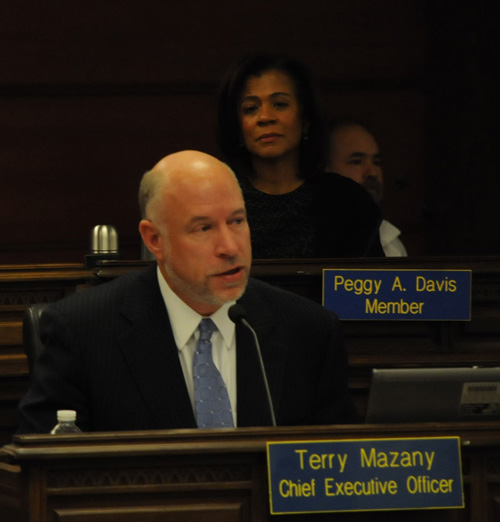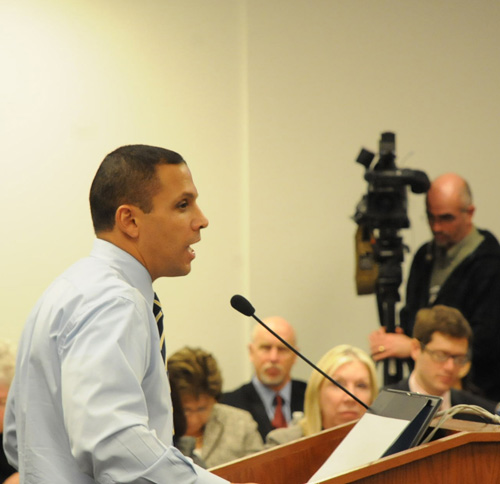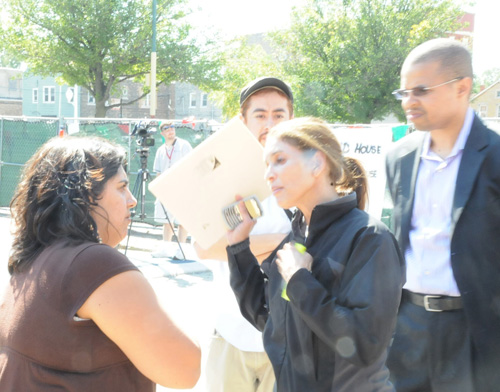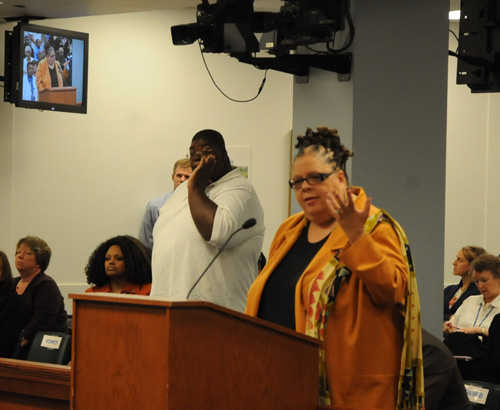Mazany sneaks out last-minute list of the dubious achievements of CPS during 2010... No press conference on this one
You've got to wonder whether anyone showed the CPS list of "achievements" for 2010 to the new (one dollar a year) Chief Executive Officer of CPS before he allowed the CPS Communications Department (i.e., Monique Bond) issue it almost in the dead of night on the last day before 2010 ended, when everyone in the news business was covering New Year's Eve stuff. But Mazany ultimately will get credit for the stuff that CPS claims now that he's boss, so it's worth a review of precisely what CPS said it did during 2010.
 The new "Chief Executive Officer" of Chicago's public schools Terry Mazany spoke at length about his background in educational leadership (he never mentioned teaching as part of it) during the Board of Education's last meeting of the year on December 15, 2010 (above). It is unclear whether Mazany approved the massive fictionalization of the year 2010 that was distributed to the press late on December 31, 2010. Substance photo by George N. Schmidt. When he was 'Chief Executive Officer' of Chicago Public Schools, Ron Huberman touted himself as a tough guy, a genius with numbers, and a hero, making sure that the controlled media narrative he had cultivated among a small circle of intimates was the dominant one. While pieces of the dubious story came out in various ways ("ex-cop," "numbers guy") the most delightful example appeared in the August 2009 edition of Chicago magazine. The story was mindless hagiography, although the write who crafted it and the editors who approved it were doubtless paid well by the standards of reporting in Chicago that year. Meanwhile, Huberman avoided critical media questions like those old ladies in the cartoons who see a mouse and jump up on a chair going "EEEEKKK!" Not once during his final year in office did Huberman face down factual questions about the stuff he was claiming, from "billion dollar" deficits to the success of the $60 million patronage scam called "Culture of Calm." Courage in Huberman's narrative didn't have to do with standing behind the claims he was making.
The new "Chief Executive Officer" of Chicago's public schools Terry Mazany spoke at length about his background in educational leadership (he never mentioned teaching as part of it) during the Board of Education's last meeting of the year on December 15, 2010 (above). It is unclear whether Mazany approved the massive fictionalization of the year 2010 that was distributed to the press late on December 31, 2010. Substance photo by George N. Schmidt. When he was 'Chief Executive Officer' of Chicago Public Schools, Ron Huberman touted himself as a tough guy, a genius with numbers, and a hero, making sure that the controlled media narrative he had cultivated among a small circle of intimates was the dominant one. While pieces of the dubious story came out in various ways ("ex-cop," "numbers guy") the most delightful example appeared in the August 2009 edition of Chicago magazine. The story was mindless hagiography, although the write who crafted it and the editors who approved it were doubtless paid well by the standards of reporting in Chicago that year. Meanwhile, Huberman avoided critical media questions like those old ladies in the cartoons who see a mouse and jump up on a chair going "EEEEKKK!" Not once during his final year in office did Huberman face down factual questions about the stuff he was claiming, from "billion dollar" deficits to the success of the $60 million patronage scam called "Culture of Calm." Courage in Huberman's narrative didn't have to do with standing behind the claims he was making.
The actual fact was that Huberman wouldn't face the press if he couldn't control the entire event. Every time he was asked a direct question that he couldn't lie his way through, he cut and ran. The last unscripted press conference Huberman held was during his first months in office. He appeared briefly with Michael Scott (who had just been pulled back to CPS by Mayor Daley after the debacle of Rufus Williams) after a Board of Education meeting and by the third question, he got the hook from CPS Communications Chief Monique Bond. Scott and Huberman were rushed out of the room while reporters continued asking questions they didn't want to answer.
 Although outgoing CPS CEO Ron Huberman didn't utilize his traditional Power Point crutches during his final teacher bashing report to the Board of Education on November 17, 2010, he did huddle with his trusty Dell computer throughout the lecture he delivered to the Board members (only five of whom were present) and the public. Among other things, Huberman quoted an outrageous piece of "data" claiming that within one student lifetime of 12 or 13 years a student in Houston, Texas, gets "four additional years" of schooling when compared to a student in Chicago, which supposedly has the shortest school day, week, month and year of any school system anywhere, according to Huberman's final blast of dubious data. As usual, the members of the Board of Education nodded approvingly and uncritically at Huberman's spewings, leaving any clarification of the public record to community groups and researchers at the Chicago Teachers Union. No one asked Huberman publicly why he was abandoning the public schools of Chicago in mid-year after his repeated proclamations of his devotion to CPS workers and kids. Substance photo by George N. Schmidt. Thus it's no surprise that after one month of Terry Mazany as CEO the same nonsense occurs. The official end-of-the-year report on how great things are in this best of all possible school systems was released as a press release by Monique Bond on December 31, 2010, without any press briefing or press conference. It's as if Mazany, like Huberman, hope that some corporate media hack will simply reprint the three pages Bond has shoveled out.
Although outgoing CPS CEO Ron Huberman didn't utilize his traditional Power Point crutches during his final teacher bashing report to the Board of Education on November 17, 2010, he did huddle with his trusty Dell computer throughout the lecture he delivered to the Board members (only five of whom were present) and the public. Among other things, Huberman quoted an outrageous piece of "data" claiming that within one student lifetime of 12 or 13 years a student in Houston, Texas, gets "four additional years" of schooling when compared to a student in Chicago, which supposedly has the shortest school day, week, month and year of any school system anywhere, according to Huberman's final blast of dubious data. As usual, the members of the Board of Education nodded approvingly and uncritically at Huberman's spewings, leaving any clarification of the public record to community groups and researchers at the Chicago Teachers Union. No one asked Huberman publicly why he was abandoning the public schools of Chicago in mid-year after his repeated proclamations of his devotion to CPS workers and kids. Substance photo by George N. Schmidt. Thus it's no surprise that after one month of Terry Mazany as CEO the same nonsense occurs. The official end-of-the-year report on how great things are in this best of all possible school systems was released as a press release by Monique Bond on December 31, 2010, without any press briefing or press conference. It's as if Mazany, like Huberman, hope that some corporate media hack will simply reprint the three pages Bond has shoveled out.
Here it is, the official version of 2010 in Chicago's public schools.
CPS END OF THE YEAR PRESS RELEASE
For more information contact: Monique Bond, CPS Office of Communications, Phone: 773-553-1620, Fax: 773-553-1622, Website: http://www.cps.edu
FOR IMMEDIATE RELEASE: December 31, 2010
Chicago Public Schools Year-End Accomplishments: Gains in test scores, increase in college enrollment & preparing students for future careers
Managing through significant financial challenges while protecting classroom resources, along with promoting the safety and security of students and launching initiatives aimed at improving student outcomes marked 2010 for Chicago Public Schools.
The District built on earlier successes in such areas as increased student test scores, higher graduation and college enrollment rates, and lower drop-out rates, continuing the progress it has made since Mayor Richard M. Daley took leadership of CPS 15 years ago.
 One of the few events from Chicago's public schools to make national news during 2010 was the 43-day sit in of mothers and others at Whittier Elementary School in Chicago. The sit-in was demanding a library for the children, and volunteers from across the country provided library services and books as the story got out both through indy media and in the mainstream (see TV camera in background above). When the story finally got out, it turned out that Chicago had 160 elementary schools without libraries in 2010 -- the 15th year of the mayoral control miracle. But there was no mention of the Whittier struggle or the reality it unmasked in the CPS end of the year report prepared by Monique Bond (above, center, holding folder). At the time the photograph above was taken, Bond and the politically connected CPS security chief Michael Shields (above right) were preparing to call on Chicago police to arrest the mothers leading the sit-in, including Gema Gaeta (left). Bond never made the call for the arrests because a few minutes after the above photograph was taken hundreds of supporters broke through a police cordon and swarmed up to the field house, causing the police to withdraw. Nothing about the struggle and its implications was reported by Bond in her end-of-the-year report to the press. Substance photo by George N. Schmidt. This year the District reported gains in elementary school Illinois State Achievement Test scores as well as the Prairie State Achievement Exam taken by high school students, and advanced an ambitious program to remake career education in high schools.
One of the few events from Chicago's public schools to make national news during 2010 was the 43-day sit in of mothers and others at Whittier Elementary School in Chicago. The sit-in was demanding a library for the children, and volunteers from across the country provided library services and books as the story got out both through indy media and in the mainstream (see TV camera in background above). When the story finally got out, it turned out that Chicago had 160 elementary schools without libraries in 2010 -- the 15th year of the mayoral control miracle. But there was no mention of the Whittier struggle or the reality it unmasked in the CPS end of the year report prepared by Monique Bond (above, center, holding folder). At the time the photograph above was taken, Bond and the politically connected CPS security chief Michael Shields (above right) were preparing to call on Chicago police to arrest the mothers leading the sit-in, including Gema Gaeta (left). Bond never made the call for the arrests because a few minutes after the above photograph was taken hundreds of supporters broke through a police cordon and swarmed up to the field house, causing the police to withdraw. Nothing about the struggle and its implications was reported by Bond in her end-of-the-year report to the press. Substance photo by George N. Schmidt. This year the District reported gains in elementary school Illinois State Achievement Test scores as well as the Prairie State Achievement Exam taken by high school students, and advanced an ambitious program to remake career education in high schools.
Changes in operating procedures and record keeping were also introduced to ensure fairness, equal access and transparency.
CPS began the process of developing its fiscal 2010-11 budget facing as much as a billion dollar deficit. District officials engaged with other school leaders from around the state to press Illinois lawmakers for additional funding, given the national economic downturn that has affected public agency revenues all over the country.
The state was, and at year’s end remains, hundreds of millions of dollars behind in its promised aid payments to CPS, forcing officials to look at other measures to manage through the crisis.
As the budgeting process progressed, the District was able to reduce the projected deficit through a number of actions, beginning with pension relief and reform enacted by the Legislature. Locally, officials took actions such as instituting Central Office and citywide staffing efficiencies, requiring non-union non-school-based staff to take 15 unpaid furlough days, utilizing available federal funds and establishing a line of credit to maintain an appropriate operating balance.
Ultimately, the Chicago Board of Education in August approved a $5.177 operating budget that maintained programmatic and classroom resources.
Despite the challenging economic times, teaching and learning accomplishments and initiatives remained front and center for the District:
 Although limited to only two minutes during the final Ron Huberman meeting of the Chicago Board of Education on November 17, 2010, Chicago Teachers Union President Karen Lewis managed to correct a significant number of the lies, half truths, and distorted data sets that had earlier been presented by outgoing CEO Ron Huberman. Substance photo by George N. Schmidt. -- Illinois State Board of Education data showed that CPS elementary school students meeting or exceeding state standards in 2010 reached 71.7 percent, up from 41.1 in 2002. The CPS “meets/exceeds” score for 2010 on the Illinois Standards Achievement Test was 1.9 percentage points higher than last year’s meets/exceeds score. (Scores do not include students who are English Language Learners.) CPS has shown continued progress in the numbers of its students both meeting and exceeding state standards and those exceeding state standards since 2002. Science scores rose 3.6 percentage points to 67.9; math was up 2.8 percentage points to 76.4 and reading scores gained .5 percentage points to 68.3.
Although limited to only two minutes during the final Ron Huberman meeting of the Chicago Board of Education on November 17, 2010, Chicago Teachers Union President Karen Lewis managed to correct a significant number of the lies, half truths, and distorted data sets that had earlier been presented by outgoing CEO Ron Huberman. Substance photo by George N. Schmidt. -- Illinois State Board of Education data showed that CPS elementary school students meeting or exceeding state standards in 2010 reached 71.7 percent, up from 41.1 in 2002. The CPS “meets/exceeds” score for 2010 on the Illinois Standards Achievement Test was 1.9 percentage points higher than last year’s meets/exceeds score. (Scores do not include students who are English Language Learners.) CPS has shown continued progress in the numbers of its students both meeting and exceeding state standards and those exceeding state standards since 2002. Science scores rose 3.6 percentage points to 67.9; math was up 2.8 percentage points to 76.4 and reading scores gained .5 percentage points to 68.3.
-- College enrollment of CPS high school graduates increased for the fifth consecutive year at a rate that outpaces the nation. In 2009, more than 10,000 CPS graduates went on to college — an all-time high — and the college enrollment rate now stands at 54.4 percent, up from 52.5 percent in 2008. In 2004, when CPS first began tracking how many of its graduates enrolled in college, 43.5 percent of former students enrolled in a post-secondary institution. The 10.9-percentage point CPS increase since then far outpaces the national increase of 3.4 points.
-- Three CPS middle schools — Evergreen, Libby and Little Village Academy — were named as Illinois Horizon “Schools to Watch” by the Association of Illinois Middle-Level Schools and the National Forum to Accelerate Middle-Grades Reform. Schools to Watch is a nationally recognized, state-operated model school identification and school improvement program that focuses on students in grades 5-8. Illinois is one of 18 states across the nation to participate in Schools to Watch and currently, only 16 schools in Illinois have Schools to Watch designation. The three schools joined Thurgood Marshall Middle School as Schools to Watch within CPS.
-- The District is undertaking a comprehensive re-structuring of its Career and Technical Education programs that will reorganize 250 non-standardized career programs into 80 “College and Career Academies” at 35 high schools in the coming years. The first 30 College and Career Academies opened in 12 high schools this past fall. The academies will be open to citywide enrollment, an improvement over the former CTE program which many students weren't able to access outside of their neighborhood.
The academies this year are offering programs in construction, architecture, culinary arts, hospitality, pre-engineering, auto technology and auto body repair, business and finance, medical and health careers, cosmetology, information technology, child care and childhood education, law and public safety, logistics and broadcast technology.
-- A financial literacy program was launched for 900 CPS students citywide in February. Eight core areas are part of the curriculum, including post-secondary planning, budgeting, saving and investing, spending, credit, insurance and an economic way of thinking. Students in the program learn to develop realistic, measurable financial goals and plan budgets to achieve those goals. The program takes students beyond the classroom by requiring field experiences, including a visit to a four-year university and a city college to speak with representatives about financial aid. Students will also have access to "What’s Next Illinois," an interactive website that is utilized by the CPS Department of College and Career Preparation and every school. Classes will also have the opportunity to visit the Chicago Mercantile Exchange, the Federal Reserve Bank and a bank within their community.
-- A pilot program employing online reading and mathematics instruction was begun in five elementary schools last fall. The Additional Learning Opportunities initiative, which will be expanded to 10 additional schools after January 1, serves to extend the CPS school day with an academic focus. Officials are viewing the ALO initiative as a way to provide more student learning time, improve student outcomes and offset the short CPS school day and school year.
CPS’ Culture of Calm vision to create safe and engaging environments for students continues to flourish. Six plot schools have developed school transformation plans that promote positive behavior reinforcement, disciplinary alternatives to suspension, and staff engagement.
-- The District also partnered with faith leaders and community organizations on a pair of Safe Haven programs, one during the summer and another during the year-end holiday vacation.
Kindergarten-through-12th grade students in targeted communities were eligible to participate in the Safe Haven programs; about 1,000 students were served in the summer and some 2,500 during the holidays.
The programs focused on the theme “Stop the Violence, Stop the Silence,” and engaged students in creative activities and discussion.
-- District officials continued to monitor and, as needed, adjust admissions policies for the District’s selective enrollment and magnet schools.
A review of the one-year admissions policy, adopted last year following the end of the federal desegregation consent decree, was carried out by a Blue Ribbon Commission, with recommendations then forwarded to the Board of Education.
The District also opened up 25 seats at each of four top selective enrollment high schools for high-scoring eighth graders at low-performing elementary schools as an additional measure to foster diversity in those schools.
-- CPS officials during 2010 took a number of steps to increase operational transparency in the District.
The District’s web site now contains “position rosters”, which list in detail every employee, job title and that employee’s salary. Also posted online was a breakdown of committed consultant dollars spent by the District.
-- Further, the District established a committee that will review non-competitive procurement requests and help determine the validity and adequacy of those requests.
-- The Chicago Board of Education established an Audit and Finance Committee which met for the first time in November.
-- CPS in 2010 also introduced new nutritional standards throughout the District and set the stage for schools to engage in the federal governments “Go for the Gold” campaign on childhood wellness.
-- The District continues to expand its Breakfast in the Classroom program. Students now receive a greater variety of fruits, vegetables and whole grains; dessert or candy-like breakfast items will no longer be offered in CPS cafeterias. Salad bars are being placed in more schools. The District is also committed to cutting sodium in the food it serves by 5 percent annually.
Other 2010 highlights:
-- Chicago attorney Mary Richardson-Lowry was chosen in January by the Mayor to become president of the Chicago Board of Education. The Mayor in November also named Terry Mazany, president and chief executive officer of the Chicago Community Trust, as Interim Chief Officer of the District.
-- Some 195 schools – both elementary and high schools – are now operating on the District’s “Track E”, or year-round, calendar, almost a 50 percent increase in the number of schools to adopt that schedule.
-- Five newly constructed buildings, part of the Mayor’s Modern Schools Across Chicago initiative, opened this year: Solorio High School and West Ridge, Azuela, Calmeca and Lorca elementary schools.
-- Chicago Public Schools students raised and donated more than $224,000 to the American Red Cross for Haitian relief following the earthquake in the Caribbean island nation.
-- A “virtual” summer school program was implemented to increase focus on the individual needs of students. The online summer program allowed for both credit recovery and accelerated learning for students seeking additional opportunities.
Chicago Public Schools serves approximately 410,000 students in more than 670 schools. It is the nation’s third-largest school system.


By: Mrs. Johnson
Graduates Going to College
Only "10,000 CPS graduates went on to college" ??? What percentage is that over the total of students graduating from H.S.?